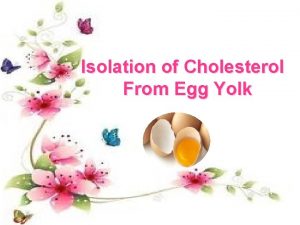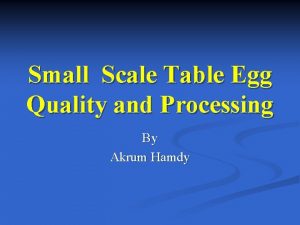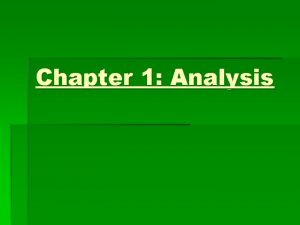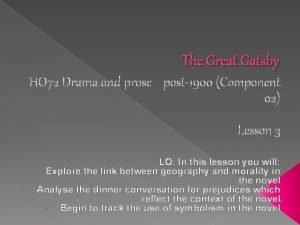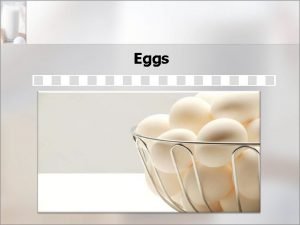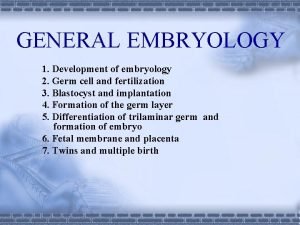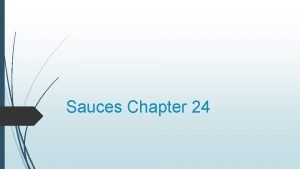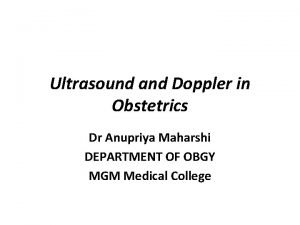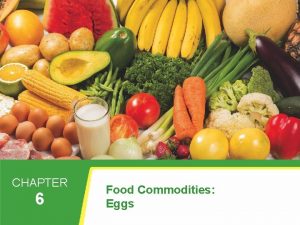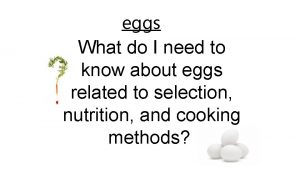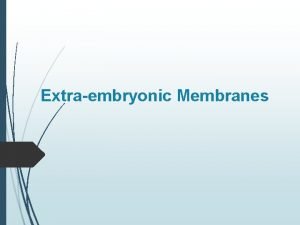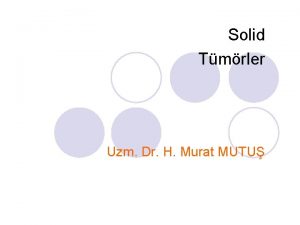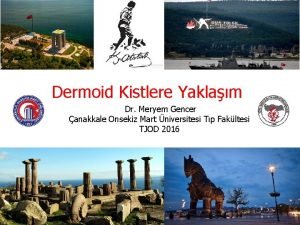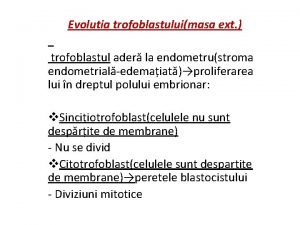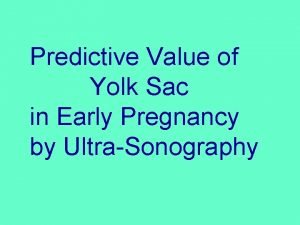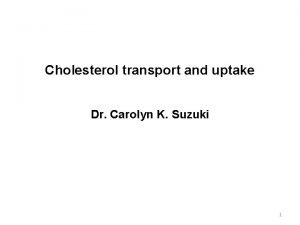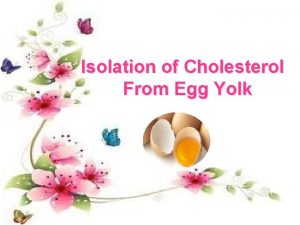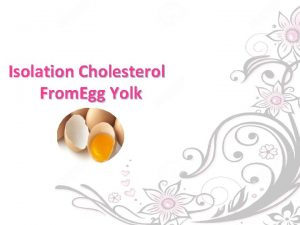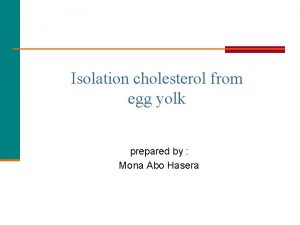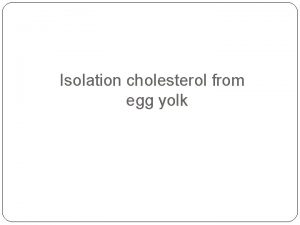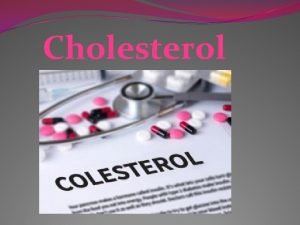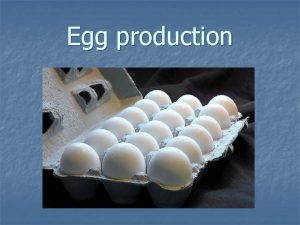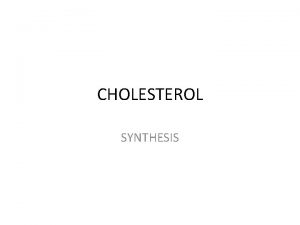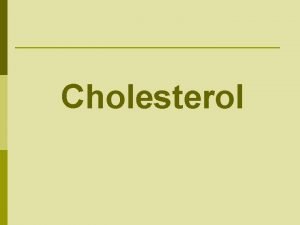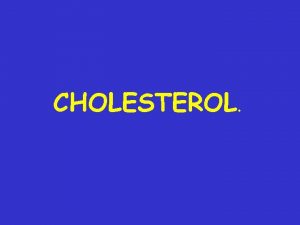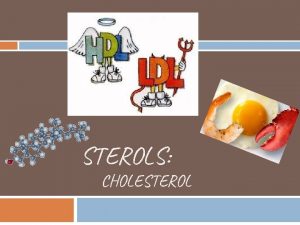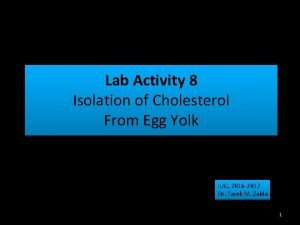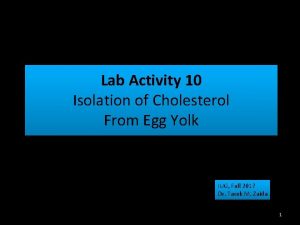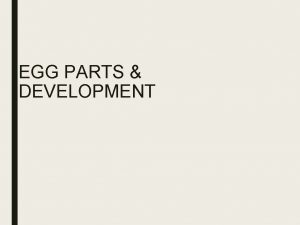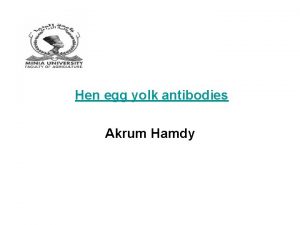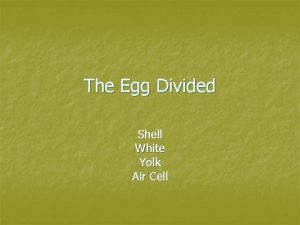Isolation Cholesterol From Egg Yolk Cholesterol Is the





















- Slides: 21

Isolation Cholesterol From Egg Yolk

Cholesterol Ø Is the most abundant steroid in the body. Ø Is a waxy substance found in all of the body cells. Ø Has methyl CH 3 - groups, alkyl chain, and OH attached to the steroid nucleus.

Help and maintain cell membranes. Protect and insulate nerve fibers. Involved in the formation of sex hormones, such as estrogen. Production of bile salts, which help digesting fats.

• Is obtained from meats, milk, and eggs. • Is synthesized in the liver. • Is needed for cell membranes, brain and nerve tissue, steroid hormones, and Vitamin D. • Clogs arteries when high levels form plaque. A normal, open artery. An artery clogged by cholesterol plaque

Cholesterol is • Synthesized in the liver. • Obtained from foods. • Considered elevated if plasma cholesterol exceeds 200 mg/d. L. TABLE 17. 4 Copyright © 2007 by Pearson Education, Inc. Publishing as Benjamin Cummings

Lipoproteins • Combine lipids with proteins and phospholipids. • Are soluble in water because the surface consists of polar lipids. Copyright © 2007 by Pearson Education, Inc. Publishing as Benjamin Cummings

Lipoproteins • Differ in density, composition, and function. • Include low-density lipoprotein (LDLs) and highdensity lipoprotein (HDLs). TABLE 17. 5 Copyright © 2007 by Pearson Education, Inc. Publishing as Benjamin Cummings

Transport of Lipoproteins in the Body

Low-density lipoprotein (LDL) • Low-density lipoproteins transport cholesterol throughout the body, delivering cholesterol to different tissues and organs. When the cells have all the cholesterol they need, they reduce the number of receptors, or gateways, for cholesterol to enter. As a result, cholesterol contained in the LDL particles (LDL cholesterol) starts to build up in the blood stream.

• Over time, circulating LDL cholesterol undergoes chemical changes (becomes oxidized) and also reduces in size. These smaller particles more easily enter the blood vessel wall and start to build up under the vessel lining. Deposits of LDL cholesterol particles in vessel walls are called plaques and can lead to inflammation, bleeding into the area, and calcium buildup (calcification). Eventually, the buildup of plaques can start to crowd the space within the blood vessel and obstruct the blood flow. This process of plaque accumulation is called Atherosclerosis.

• When atherosclerosis affects the arteries leading to the heart (coronary arteries), one may have chest pain and other symptoms of coronary artery disease. If plaques tear or rupture, a blood clot may form — blocking the flow of blood or breaking free and plugging an artery downstream. If blood flow to part of the heart stops, a heart attack will occur. If blood flow to the brain stops, a stroke occurs. This is why LDL cholesterol is often referred to as ―Bad cholesterol.

High-density lipoprotein (HDL) • Rather than deliver cholesterol to cells, high-density lipoproteins leave the liver with very little cholesterol, pick up excess cholesterol on their route through the bloodstream and take it back to your liver. The liver excretes this cholesterol into the bile and out of the body through the bowels. Because HDL particles remove excess cholesterol from the body, they are considered protective. That’s why HDL cholesterol is often referred to as ― Good cholesterol.

Egg white Albumin Egg yolk Lipids + glycoproteins Hen egg

5% Cholesterol Egg yolk 66% glycerides 28% phospholipids

• Egg yolk is rich in lipids of which the most two prominent are cholesterol and phosphatidyl choline (lectithin) 15 – Phosphatidylcholine (once given the trivial name 'lecithin') is usually the most abundant phospholipid in animals and plants, often acounting to almost 50% of the total, and as such it is obviously a key building block of membrane bilayers. – In particular, it makes up a very high proportion of the outer leaflet of the plasma membrane. Phosphatidylcholine is also the principal phospholipid circulating in plasma, where it is an integral component of the lipoproteins, especially the HDL. – On the other hand, it is less often found in bacterial membranes, perhaps 10% of species, but there is none in the 'model bacteria', Escherichia coli and Bacillus subtilis.

Experiment • Reagents and instruments – A hard boiled hen egg – Acetone, Ice, Water bath, Erlenmeyer flask, Funnel, Filter paper, 250 ml beaker

Principle Based on the solubility in different organic solvent, lipids can be separated from each other. Cholestrol is readily soluble in acetone, while most complex lipids are insoluble in this solvent. Acetone (systematically named propanone) is the organic compound with the formula (CH 3)2 CO. It is a colorless, volatile, flammable liquid, and is the simplest ketone. 17

1. Peal the hard boiled egg and remove the egg white. 2. In a 250 ml beaker weigh a ½ egg yolk and mash it. 3. To the mashed egg yolk add a 25 ml of acetone and keep stirring for 5 min. 4. Allow the solid to settle and carefully remove the acetone (the above liquid phase) and transfer it to a clean 100 ml Erlenmeyer flask and cover it tightly. 5. To the remained solid phase add a new 25 ml of acetone and repeat step 4. Now you have collected twice the 25 ml of acetone extract (it contains the cholesterol).

1. Using a funnel and a filter paper, filter the 50 ml of acetone extract into a clean 100 ml beaker. 2. Evaporate the acetone by placing the beaker on the steam bath in the hood until about 10 ml of extract is left. 3. Cover the warm acetone extract and immediately transfer it on ice and let it stand for 20 min. A white precipitate will form (this is the crude cholesterol). Remove the flask from ice. Get rid of the liquid phase.

4. To the cholesterol precipitate add 15 ml of acetone and stir at room temp. Note that not all precipitate will dissolve (the contaminating phospholipids remain insoluble). 5. Weigh a clean, dry watch glass. Filter the dissolved cholesterol solution into the pre-weighed watch glass. Allow the acetone to evaporate in the hood. The remained crystals is the cholesterol. 6. Weigh the watch glass with cholesterol. Calculate the yield of cholesterol.

The End
 Isolation of cholesterol from egg yolk principle
Isolation of cholesterol from egg yolk principle Firmness of the yolk and freedom from yolk defects
Firmness of the yolk and freedom from yolk defects Double yolk chicken eggs hatching
Double yolk chicken eggs hatching West egg and east egg
West egg and east egg The great gatsby geography
The great gatsby geography Map of the great gatsby setting
Map of the great gatsby setting East egg the great gatsby
East egg the great gatsby West egg and east egg
West egg and east egg West egg and east egg
West egg and east egg East egg west egg
East egg west egg Coagulation in egg
Coagulation in egg Cell phase
Cell phase A yolk and cream mixture that is used to thicken liquids *
A yolk and cream mixture that is used to thicken liquids * Dr anupriya maharshi
Dr anupriya maharshi Yolk composition
Yolk composition Function of yolk
Function of yolk Extraembryonic membranes
Extraembryonic membranes Wilms tümörü nöroblastom ayrımı
Wilms tümörü nöroblastom ayrımı Magnof
Magnof Sacul yolk
Sacul yolk Rhobencephalon
Rhobencephalon Chylomicron
Chylomicron
